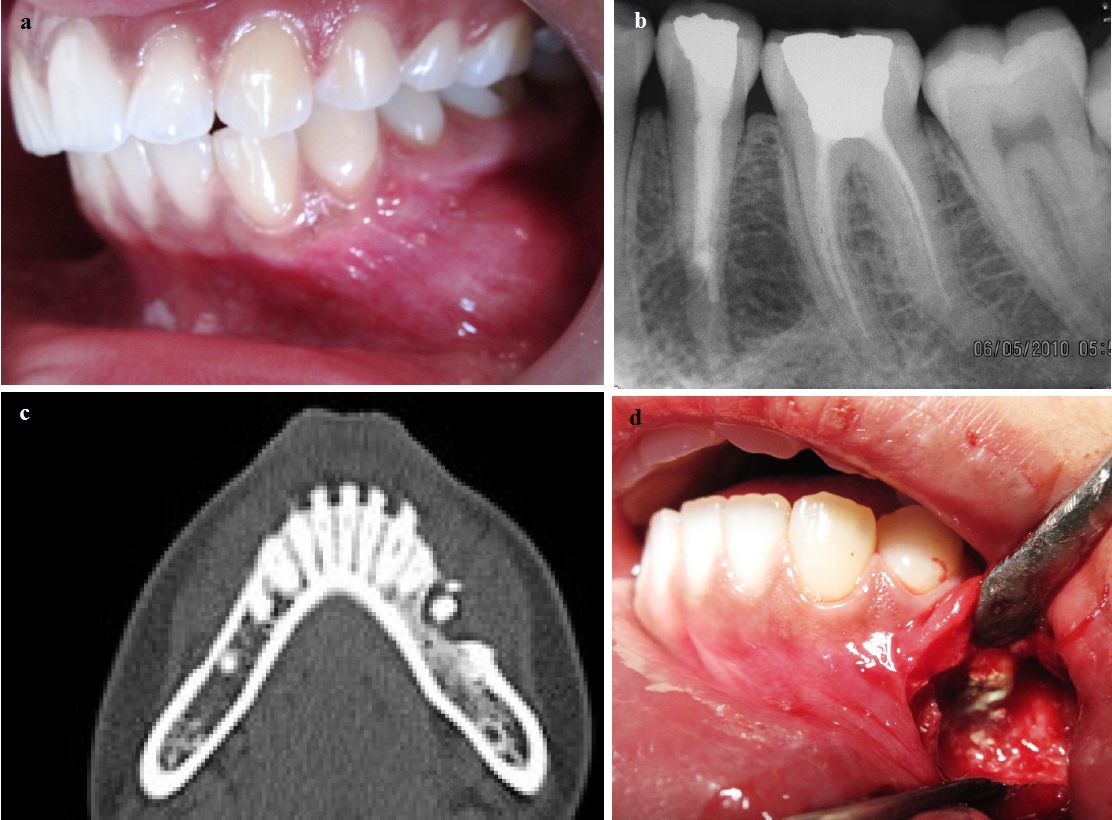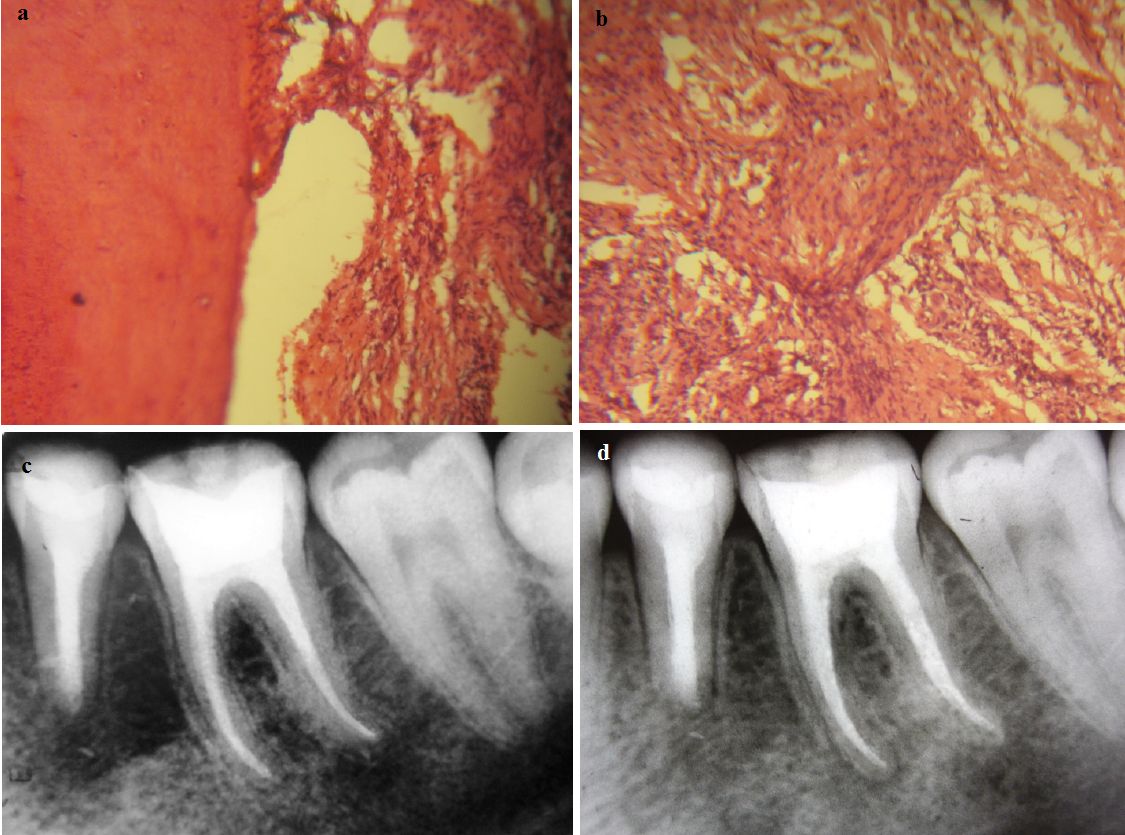Radicular Cyst with Severe Destruction of the Buccal Cortical Plate Secondary to Endodontic Failure
Rajdeep Pavaskar1, Tarun Gera2, Chandra Mohan Boyapati3, Paul Chalakkal4, Sushma Bommannavar5
1 Senior Lecturer, Department of Coservative Dentistry and Endodontics, Index Institute of Dental Sciences, Indore-452001, Madhya Pradesh, India.
2 Professor and Head, Department of Coservative Dentistry and Endodontics, Index Institute of Dental Sciences, Indore-452001, Madhya Pradesh, India.
3 Reader, Department of Coservative Dentistry and Endodontics, Index Institute of Dental Sciences, Indore-452001, Madhya Pradesh, India.
4 Lecturer, Department of Pedodontics and Preventive, Dentistry, Goa Dental College and Hospital, Bambolim-403202, Goa, India.
5 Lecturer, Department of Oral Pathology, School of Dental Sciences, Krishna Institute of Medical Sciences, Satara-415110, Maharashtra, India.
NAME, ADDRESS, E-MAIL ID OF THE CORRESPONDING AUTHOR: Dr. Paul Chalakkal, Lecturer, Department of Pedodontics and Preventive Dentistry, Goa dental College and Hospital, Bambolim-403202, Goa, India.
Phone: 91-99605 83896, Email: atomheartpaul@yahoo.com
This case report highlights a massive radicular cyst with respect to the lower left premolars, that developed secondary to endodontic failure and resulted in buccal cortical bone destruction. It also discusses the investigation and the surgical approach which were carried out with regard to the cyst. Following surgical closure, the teeth were endodontically retreated. It also highlights the fact that mandibular true occlusal radiographs could be misleading with regard to the extent of bone destruction, which can otherwise be confirmed on CT scans.
Radicular cyst, Buccal cortical plate, Endodontic failure
Case Report
An 18-years old female patient reported to the Department of Conservative Dentistry and Endodontics with the complaint of a firm, non- tender swelling on the buccal gingiva, in relation to the lower left premolar region [Table/Fig-1a]. She had undergone root canal therapy 18 months back for teeth 35 and 36, that were obturated after multiple appointments with gutta percha using a zinc oxide based sealer. She was apparently alright for six months following root canal therapy, after which she noticed a swelling in relation to 35 and 36. Intra-oral examination revealed a diffuse, firm and a non- tender swelling which measured 1.5cm x 2cm on the gingiva in relation to 35 and 36. The associated lymph nodes were non palpable and non tender. Both 35 and 36 were found to be non-tender to percussion and non vital on electronic pulp testing.
(a) The gingival swelling in relation to 35; (b) Periapical radiograph in relation to 35 and 36; (c) CT scan revealing destruction of the buccal cortical plate; (d) Root end resection for 35.

A periapical radiograph [Table/Fig-1b] revealed an ill-defined radiolucency in relation to 35 and 36. A radio-opaque material was found to terminate four millimetres short of the apex in 35. A faint radio-opaque line was found to exit the root of 35, four millimetres short of the apex, which was suggestive of a perforation, which was later confirmed by using an apex locater and on radiographs. A radio-opaque obturating material was seen 3.5mm short of the apices of 36. A CT scan revealed destruction of the buccal cortical plate [Table/Fig-1c].
An envelope incision was made, starting from the distal aspect of 32, up to the mesial aspect of 36. A blunt dissection was carried out to identify the mental nerve and foramen. Curettage and enucleation of the cyst was carried out while preserving the mental nerve, by using small right angle retractors. The flap was retracted by using a Catspaw retractor. Root end resection was done for 35 at the level of the perforations [Table/Fig-1d]. Root end preparation was done using a tungsten carbide bur to a depth of three millimetres and was sealed with MTA. The enucleated tissue was sent for a histopathological examination. Following surgical closure, 35 was endodontically treated using the conventional orthograde approach. Composite restorations were done for 35 and 36.
Discussion
Radicular cysts are classified as epithelial lined, inflammatory and odontogenic cysts and they account for approximately 70% of all jaw cysts [1]. They form within a chronic apical granuloma which forms secondary to chronic inflammatory stimuli caused by necrotic pulp tissue [2]. Stimulation of cell rests of Malassez (remnants of the Hertwig’s root sheath), which are found in the periodontal membrane, also contribute to the epithelial formation of these cysts [3].
Recently, the role of VEGF (Vascular Endothelial Growth Factor) and MMP-9 (Matrix Metalloproteinase-9) have been suggested in the angiogenesis of radicular cysts [4]. Treatment is based on making an endodontic approach to the concerned tooth [5]. When this treatment fails to resolve the periradicular pathosis, periapical surgery must be considered [6].
Histopathological examination of the excised tissue revealed a cystic cavity lined by hyperplastic, non-keratinized, stratified squamous epithelium (magnification 40 x). The cystic wall contained collagen fibres, fibroblasts, vessels and chronic inflammatory cells [Table/Fig-2a,b].
(a, b) Histological examination of the cyst (magnification 40 X); (c) Radiograph taken six months after surgery; (d) Radiograph taken three years after surgery.

On fine needle aspiration cytology, the protein content of the cysts was found to be 5.5 g/dl. Since the internal pressure gradient is more than that of its surrounding tissues, fluid is attracted into the cyst cavity by osmotic pressure and its expansion continues as long as the wall of the lesion is intact. The growth of radicular cysts is accompanied by local bone destruction, tissue osteolysis and accumulation of different cells in the cystic epithelium. During this process, TNF-α gets accumulated in the cystic fluid [7].
Radicular cysts are usually less than one centimetre in diameter and they are bordered by a thin rim of cortical bone [8]. However, in this case, the radicular cyst was unusually large, with a diameter of 3-4 cms, which resulted in complete destruction of the buccal cortical plate. A radiographic evaluation done six months after surgery, revealed a reduction in periradicular radio-lucency, suggestive of a favourable healing process [Table/Fig-2c]. A radiograph which was taken three years postoperatively, demonstrated excellent periradicular repair with the presence of lamina dura and bone trabeculae in relation to 35 [Table/Fig-2d]. The mandibular true occlusal radiograph could have been misleading with regard to the extent of destruction in the buccal cortical plate, which could otherwise be confirmed on a CT scan.
[1]. Soames JV, Southam JC, Cysts of the jaws and oral soft tissuesIn Oral Pathology 1999 3rd editionOxfordOxford University Press:73-92.Edited by: Soames JV, Southam JC [Google Scholar]
[2]. Walker KF, Lappin DF, Takahashi K, Hope J, Macdonald DG, Cytokine expression in periapical granulation tissue as assessed by immunohistochemistryEur J Oral Sci 2000 108:195-201. [Google Scholar]
[3]. Lia RC, Garcia JM, Sousa-Neto MD, Saquy PC, Marins RH, Clinical, radiographic and histological evaluation of chronic periapical inflammatory lesionsJ Appl Oral Sci 2004 12:117-20. [Google Scholar]
[4]. Nonaka CF, Maia AP, Nascimento GJ, Almeida Freitas R, Batista de Souza L, Immunoexpression of vascular endothelial growth factor in periapical granulomas, radicular cysts, and residual radicular cystsOral Surg Oral Med Oral Pathol Oral Radiol Endod 2008 106:896-902. [Google Scholar]
[5]. Garcia CC, Sempere FV, Diago MP, Bowen EM, The post-endodontic periapical lesion: histologic and etiopathogenic aspectsMed Oral Patol Oral Cir Bucal 2007 12:585-90. [Google Scholar]
[6]. Tandri SB, Management of infected radicular cyst by surgical decompressionJ Conserv Dent 2010 13:159-61. [Google Scholar]
[7]. Jurisic V, Colic S, Jurisic M, The inflammatory radicular cysts have higher concentration of TNF-α in comparison to odontogenic kerato-cysts (odontogenic tumour)Acta Medica (Hradec Kralov) 2007 50(4):233-38. [Google Scholar]
[8]. Weber AL, Imaging of cysts and odontogenic tumors of the jawRadiol Clin North Am 1993 31:101-20. [Google Scholar]